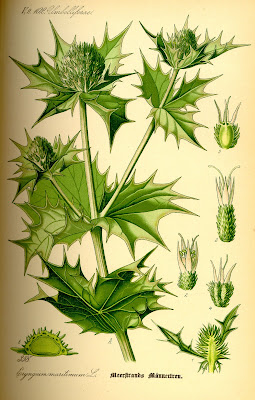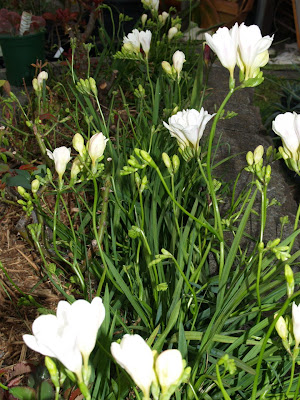 Eryngium maritimum, Sea Holly (Cardo Corredor/Cardo rolador
Eryngium maritimum, Sea Holly (Cardo Corredor/Cardo rolador)
at Meia Praia Beach ,Lagos, Portugal. photographed by Julio Reis
Eryngo or Sea Holly is an interesting plant with a fascinating history. As the common name suggests,it is a spiny leaved plant with prickly flowers having a colour blend of pewter green, turquoise and powder blue. It grows on sandy beaches just above the high water mark in Britain and Europe as well as in North Africa . In Australia, it appears occasionally as isolated specimens in places such as the sand dunes at Budgewoi on the Central Coast of New South Wales and at Wreck Beach near Port Stephens. How it arrived in Australia is difficult to determine but perhaps a seed hitched a ride on a ship from the northern hemisphere. The poet William Drummond (1585-1649) captured the essence of it in native habitat in the following verse. '...the Eryngo here Sits as a Queen among the scanty tribes of vegetable race, Here the sweet rose would die; but she imbibes from arid sand and salt sea dewdrops strength: The native of the beach, by nature formed to dwell among the ruder elements.'
It was from the late 15th to the 18th century that Eryngo was much valued as a herb and edible plant. The new green shoots were boiled and eaten like asparagus and the long roots, which travel a great distance underground, were candied and valued for their restorative powers, for treating nervous disorders as well as being a popular aphrodisiac. The poet John Dryden (1631-1701) wrote ' Who lewdly dancing at a midnight ball, For hot eryngoes and fat oysters call' ,as a reference to this latter use.
In Shakespeare's The Merry Wives of Windsor (Act 5 Sc v) Falstaff's prayer for erotic prowess and a bit of 'cool rut-time' includes a dose of eryngo:
Mistress Ford: Sir John! art thou there, my deer, my male deer? Falstaff: My doe with the black scut! Let the sky rain potatoes; let it thunder to the tune of Greensleeves, hail kissing comfits and snow eryngoes...
It could be noted here also, that the other animal which 'ruts' is the goat and the name eryngium is derived from the diminutive of the Greek eerungos meaning the beard of a goat. Plant folklore relating to eryngo also mentions the goat, as, according to Plutarch:'They report of the Sea Holly, if one goat taketh it into her mouth it causeth her first to stand still and afterwards the whole flock, until such time as the shepherd takes it from her.' Goats are not very selective grazing animals so perhaps the poor goat was so stunned to find such a prickly plant in her mouth she stood stock still.

Sea Holly/Eryngo in Flora von Deutschland, Osterich und der Schwiez 1885
Prof Dr Otto Wilhelm Thome
 Albrecht Durer self portrait with Eyrngo flower at age 22 in 1493
Albrecht Durer self portrait with Eyrngo flower at age 22 in 1493
This telling self portrait by German artist Durer was painted while he was on a 'bachelor holiday' in Europe 'sowing a few wild oats' and enjoying time away from his native city of Nuremberg where he has just finished his apprenticeship with the woodblock master Michael Wolgemuth. His father wanted him home and had arranged for him to be married to a certain Agnes Frey. What he sent home to his bride to be was this portrait with the eryngo flower ,a potent symbol of his amorous intentions ,though the whole eryngo plant was often distilled into a drink which was thought to help 'the melancholly of the heart'. A romantic notion rather than a sexual advance.
In Germany eryngo is known as krausdistil or maerwortel.
 Eryngium in The Herball of John Gerard, (1545-1612), surgeon and botanist of London published there in 1597.
Eryngium in The Herball of John Gerard, (1545-1612), surgeon and botanist of London published there in 1597.
John Gerard made many trips to the market town of Colchester in the English county of Essex which had become the centre of eryngo 'industry' ,with roots being harvested from the sandy beaches of nearby Mersea, Clacton and Dovercourt .These candied roots were advertised as cough candy and sold in attractive gilt boxes perfumed with musk and ambergris. Their manufacture was started by the apothecary Robert Buxton (Also called Thomas Buxton in some text) and on his death passed into the hands of his apprentice Samuel Great in whose family it remained until 1797.
 A box of Candied Eryngo roots from Colchester
A box of Candied Eryngo roots from Colchester
Finally, to give eryngo a modern perspective, the Encyclopedia of Herbs and their Uses by Deni Bown (RD Press ) calls Eryngium maritimum ' a sweet mucilaginous herb that is diruretic, anti-inflammatory and expectorant. ' Mention of its more provocative historical uses have all but disappeared.
2017 update: I have been unsuccessful at propagating it.

 Endymion, English-Spanish Bluebell
Endymion, English-Spanish Bluebell















